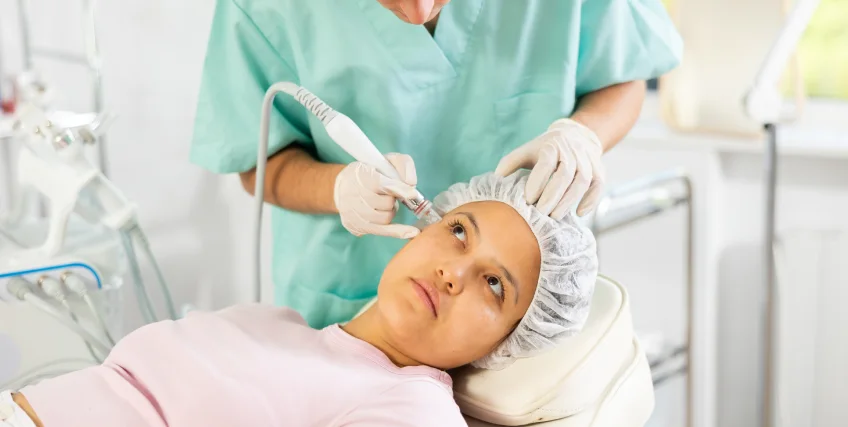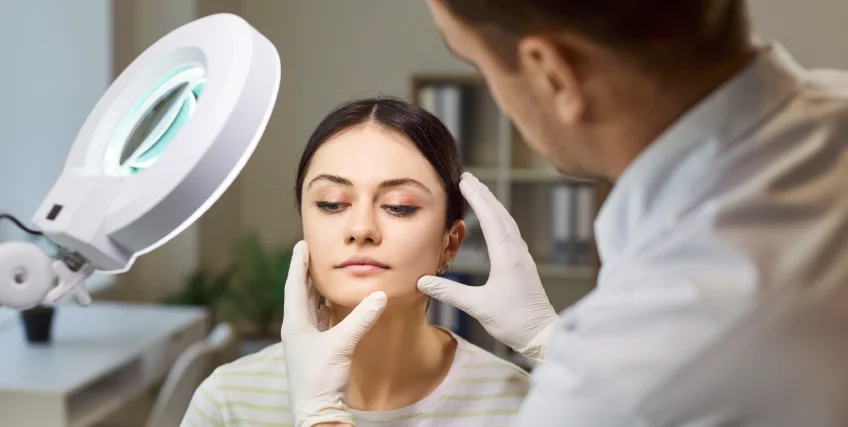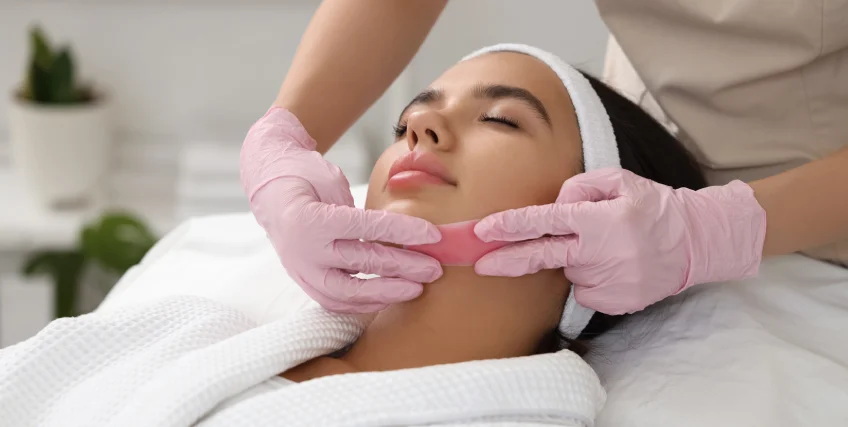How to Use a Line of Credit to Manage Cash Flow in Your Dermatology Office
August 12, 2025 | Last Updated on: August 13, 2025

Managing finances in a private dermatology practice can feel like a delicate balance, just like in any medical practice. While patient care is the top priority, you still need capital to expand a dermatology practice and address costs like payroll and equipment upgrades. A business line of credit is one of the best financing options for a growing dermatology business.
A line of credit isn’t quite like a traditional loan; it’s a flexible financial safety net that can also serve as a foundation for growth when you need capital to expand a dermatology practice. Unlike a term loan, which provides a lump sum you repay over time, a line of credit is a revolving tool that allows you to draw from a credit line when you need capital and repay what you borrow to have access to the full loan amount again. You only pay interest on what you use to withdraw, so practice owners can use lines of credit to manage cash flow as dermatology services change, your patient base slows, or there’s simply a dip in the dermatology market.
In this article:
- Why dermatology businesses may struggle with cash flow, especially given the cost of starting a dermatology practice.
- How a line of credit can support small business owners who need capital to expand a dermatology practice.
- Why a line of credit may be a more suitable alternative to bank loans, SBA loans, and other financing solutions.
The Dynamics of Cash Flow in a Dermatology Practice
Dermatology practices and partnerships have some unique cash flow challenges. Income typically relies on insurance and Medicare reimbursements, which can have varying payment cycles. You have regular fixed costs like rent, utilities, and staff salaries. Then there are variable costs – unexpected equipment repairs, the purchase of new lasers, or investing in marketing to attract new patients. Periods of slower patient volume, perhaps due to seasonal dips or increased competition, can also create tighter cash flow. Tighter cash flow can result in a worse patient experience and make it harder to provide an extensive list of services, from fillers to skin cancer treatment.
When cash flow is tight, or when you need capital to expand a dermatology practice, a line of credit can be a very useful asset. It provides the liquidity to bridge gaps, cover unexpected expenses, and seize opportunities without disrupting your core operations or dipping into your personal savings.
Ways a Line of Credit Can Help When You Need Capital to Expand a Dermatology Practice
A line of credit is a flexible, adaptable funding solution to meet a variety of practice needs, whether you’re a new practice or an established one. Here are several practical use cases of how a line of credit can help when you need capital to expand a dermatology practice or support practice management.
Bridging Income Gaps
Most of your patient base is unlikely to pay in full every time they visit. As such, your practice of financing often depends on insurance and Medicare or Medicaid reimbursements. These tend to have long wait times, which can put a strain on your primary revenue stream. A line of credit allows you to cover payroll, supplies, and other operating costs while you wait for reimbursement of payments. This ensures smooth operations and avoids any disruption to your patient’s care.
Managing Seasonal Fluctuations
Many dermatology practices experience seasonal variations in patient volume. People are likely more interested in cosmetic procedures when summer is coming around. You may have more referrals than in the winter and more in-person visits rather than telehealth ones in the winter. This may depend a bit on your particular patient demographic, but seasonal fluctuations can limit your growth potential. With a line of credit, you’ll have the financial flexibility to navigate seasonal ups and downs. This proactive approach is key when you need capital to expand a dermatology practice strategically.
Taking Advantage of Opportunities
When you need capital to expand a dermatology practice, a line of credit can help you take advantage of great business opportunities. For instance, you may have the opportunity to purchase an adjacent suite in your building to add new exam rooms or open a new location for your practice. You could find a great deal on a new, advanced laser that will enhance your service offerings and attract more patients. (You might also consider a cosmetic equipment term loan for new equipment purchases.)
When opportunities arise, you typically need quick access to capital. A line of credit gives you just that when you need capital to expand a dermatology practice and capitalize on market shifts.
Emergency Preparedness
Just as in your personal life, you can’t always prepare your business for the unexpected. Unforeseen expenses can put a strain on your cash reserves. When that strain becomes too much, a line of credit can serve as an emergency fund to address issues without disrupting your financial stability.
Inventory Management
Dermatology practices often carry a significant inventory of skincare products. Purchasing these in bulk can often lead to better pricing and increased profit margins. However, large inventory purchases also tie up your cash. A line of credit can fund these bulk purchases, allowing you to take advantage of discounts and ensure you always have the necessary supplies on hand without depleting your working capital. It can be a smart way to manage resources when you need capital to expand a dermatology practice.
Investing in Marketing and Technology
Every business needs to attract new patients and provide in-demand services to stay competitive. With a line of credit, you can pay to build a new website, create a targeted digital marketing campaign, implement new patient management software, and many more business initiatives. You typically need to make an upfront investment on marketing and technology plans, which is where a line of credit comes in.
Avoiding Dilution of Ownership
When you need capital to expand a dermatology practice, you might consider bringing in a partner or selling a stake in your practice. While this can be a great way to grow and accommodate more patients, you might also have to give up a portion of your ownership and control. With a line of credit, you could access capital without diluting your equity.
How to Get and Use a Line of Credit
Securing a line of credit is similar to applying for other business loans, although it tends to be a much faster process than traditional bank loans or SBA loans. Here’s a step-by-step process:
- Assess your needs: Before applying, carefully evaluate your practice’s financial needs. How much capital do you realistically anticipate needing to manage cash flow gaps, fund growth initiatives, or prepare for emergencies? Try to think ahead for the next 12-24 months if you can, especially if you need capital to expand a dermatology practice.
- Prepare financial documents: The documentation you need will vary by lender, but generally you’ll need business bank statements, financial statements like P&L statements and balance sheets, tax returns, accounts receivable, and a business plan. This all might not be necessary for a line of credit, but it’s best to be prepared in case you apply for other types of financing later.
- Research lenders: Look for financial institutions that specialize in healthcare lending or have experience working with small to medium-sized businesses. Compare interest rates, fees, repayment terms, and the overall application process. Traditional banks and credit unions may have lower interest rates, but online lenders may have faster approval processes.
- Assess terms: If approved, you’ll receive a loan agreement with the terms of the line of credit. Make sure you understand the interest rate, fees, repayment terms, and any restrictions or conditions you must meet to maintain the line of credit when you need capital to expand a dermatology practice.
Once you’ve secured a line of credit, remember to use it responsibly. Only draw what you need and repay the amount promptly to limit the interest accrual. It’s a good idea to keep records of your draws and repayments and incorporate repayment into your regular financial planning and budgeting.
Final Thoughts
A line of credit offers a strategic advantage that goes beyond simply having access to funds. It provides peace of mind, knowing you have a financial cushion for both anticipated and unanticipated needs. For any private dermatologist who needs capital to expand a dermatology practice, a line of credit can be a valuable asset for cash flow management and supporting sustainable growth when you need capital to expand a dermatology practice.
FAQs About Need Capital to Expand a Dermatology Practice
Is a line of credit better than a traditional loan for managing cash flow?
A line of credit is often better for managing ongoing cash flow and unexpected needs. A traditional loan provides a lump sum that you repay over a fixed period, regardless of your immediate need for funds. A line of credit is revolving; you only pay interest on the amount you draw, and you can reuse the funds as you repay them. This flexibility makes it ideal for dynamic cash flow management, particularly when you need capital to expand a dermatology practice.
What's the typical interest rate for a business line of credit?
Interest rates vary widely based on a borrower’s finances and credit score, the lender, and whether the line is secured or unsecured. Secured lines, backed by collateral, often have lower rates than unsecured ones. You should always compare offers from multiple lenders to ensure you have the best rate for your business.
Can I use a line of credit to purchase new dermatology equipment?
You may use a line of credit to purchase new equipment, but it may be less cost-effective than equipment financing. If you do use a line of credit, make sure your repayment plan aligns with how you’ll use the new equipment to generate revenue.
How does a line of credit affect my business credit score?
Like any credit product, responsible use of a line of credit can positively impact your business credit score. The opposite is also true: Late or missed payments and maxing out your line repeatedly can negatively affect your score.
What are the main differences between a secured and an unsecured line of credit?
To back the credit line, a secured line of credit requires collateral, such as accounts receivable, equipment, or real estate. Because the lender has a lower risk, secured lines typically offer higher credit limits and lower interest rates. An unsecured line of credit does not require collateral and is approved based on your practice's creditworthiness and financial stability. Unsecured lines usually have lower limits and higher interest rates due to the increased risk for the lender. When you need capital to expand a dermatology practice, considering whether you have assets to secure the line can impact your terms.




